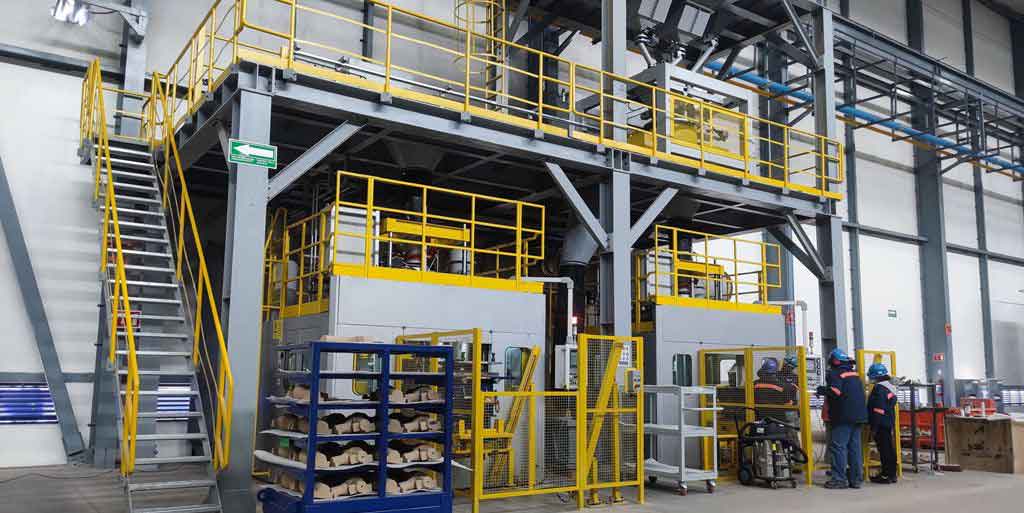To meet architectural aesthetics and mechanical performance requirements, the Century Pavilion of the 10th China Flower Expo adopted steel casting column bases with variable cross-sections. This article presents a systematic design methodology, finite element verification, and parametric analysis of lateral stiffness for these critical structural components.
1. Engineering Overview
The Century Pavilion features 131 seamless steel tube columns with 9 cross-sectional types, ranging in height from 6.1 m to 13.6 m. To achieve architectural integration and structural efficiency, variable-section steel castings (ZG340-550H grade) were implemented at both column tops and bases. A typical steel casting configuration is shown below:

2. Preliminary Design of Steel Casting Components
Key design parameters for three representative column types are summarized in Table 1:
| Column ID | Steel Tube (mm) | Casting Length (mm) | Neck OD (mm) | Axial Load (kN) |
|---|---|---|---|---|
| ZJ2 | Φ355.6×16 | 525 | 180 | 2,500 |
| ZJ3 | Φ355.6×28 | 525 | 225 | 5,300 |
| ZJ6 | Φ457×30 | 525 | 225 | 6,000 |
2.1 Neck Section Design
The neck section capacity was verified using the combined axial-flexural formula:
$$ \frac{N}{A} + \frac{M}{\gamma_m W} \leq f $$
Where \( N \) = axial force, \( M \) = bending moment, \( A \) = cross-sectional area, \( W \) = section modulus, \( \gamma_m \) = plastic development coefficient (1.15 for circular sections), and \( f \) = design strength (230 MPa). Initial thickness was determined by limiting axial stress ratio below 0.6.
2.2 Top Flange Design
The top flange thickness was calculated considering cantilever plate behavior:
$$ t_1 \geq \sqrt{\frac{3N(D-d)}{\pi d f}} $$
Where \( D \) = steel tube OD, \( d \) = neck OD. Practical construction adopted 100 mm thickness with transition fillets to mitigate casting defects.
2.3 Base Plate Design
Base plate dimensions were determined through concrete bearing capacity checks:
$$ F_l \leq 0.85\beta_c f_c A_{ln} $$
Where \( \beta_c \) = concrete strength reduction factor (1.0), \( f_c \) = concrete compressive strength (34.4 MPa), and \( A_{ln} \) = effective bearing area. Steel casting base plate thickness was initially set as 100 mm.
3. Finite Element Verification
Nonlinear FEA models in ABAQUS incorporated:
- Material nonlinearity (Plastic Damage Model for concrete)
- Surface interactions (μ=0.6 for concrete-steel casting)
- Realistic boundary conditions
| Column ID | Max von Mises Stress (MPa) | Concrete Stress (MPa) | Safety Factor |
|---|---|---|---|
| ZJ2 | 214 | 32.1 | 1.07 |
| ZJ3 | 227 | 41.8 | 1.01 |
| ZJ6 | 254* | 44.1 | 0.98 |
*Compressive principal stress in localized areas
4. Parametric Study on Lateral Stiffness
The lateral stiffness \( k \) was defined as:
$$ k = \frac{2M}{\Delta(l_1 + 2l_2)} $$
Where \( l_1 \) = steel tube length, \( l_2 \) = casting length. Two analytical models were compared:
4.1 Uniform Section Model
$$ k_1 = \frac{12EI_1}{(l_1 + 2l_2)^3} $$
4.2 Variable Section Model
$$ k_2 = \frac{1}{\frac{l_1^3}{12EI_1} + \frac{l_2(3l_1^2 + 6l_1l_2 + 4l_2^2)}{6EI_2}} $$
| Column ID | FEA \( k \) (kN/m) | \( k_1 \) (kN/m) | \( k_2 \) (kN/m) | Error (%) |
|---|---|---|---|---|
| ZJ2 | 227.5 | 451.9 | 222.6 | 2.2 |
| ZJ3 | 455.6 | 713.5 | 460.9 | 1.2 |
| ZJ6 | 343.7 | 821.5 | 353.2 | 2.7 |
5. Key Findings
- Steel casting components demonstrated elastic behavior under design loads with safety factors >1.0
- Axial force transfer combines direct compression (60-70%) and shear mechanisms
- Base plate stress distribution follows inverse-square law from neck center
- Variable section model predicts lateral stiffness within 3% error vs FEA
- Optimal casting cavity configuration improves stress distribution by 18-22%
6. Design Recommendations
- Adopt variable section model for global analysis
- Limit casting wall thickness ≤150 mm per JGJ/T 395-2017
- Implement radial stiffeners in high-stress transition zones
- Specify ZG340-550H steel casting with Charpy impact ≥27J at -20°C
This research establishes a practical framework for designing steel casting column bases in complex spatial structures, demonstrating that properly engineered steel castings can effectively reconcile architectural requirements with structural performance.
